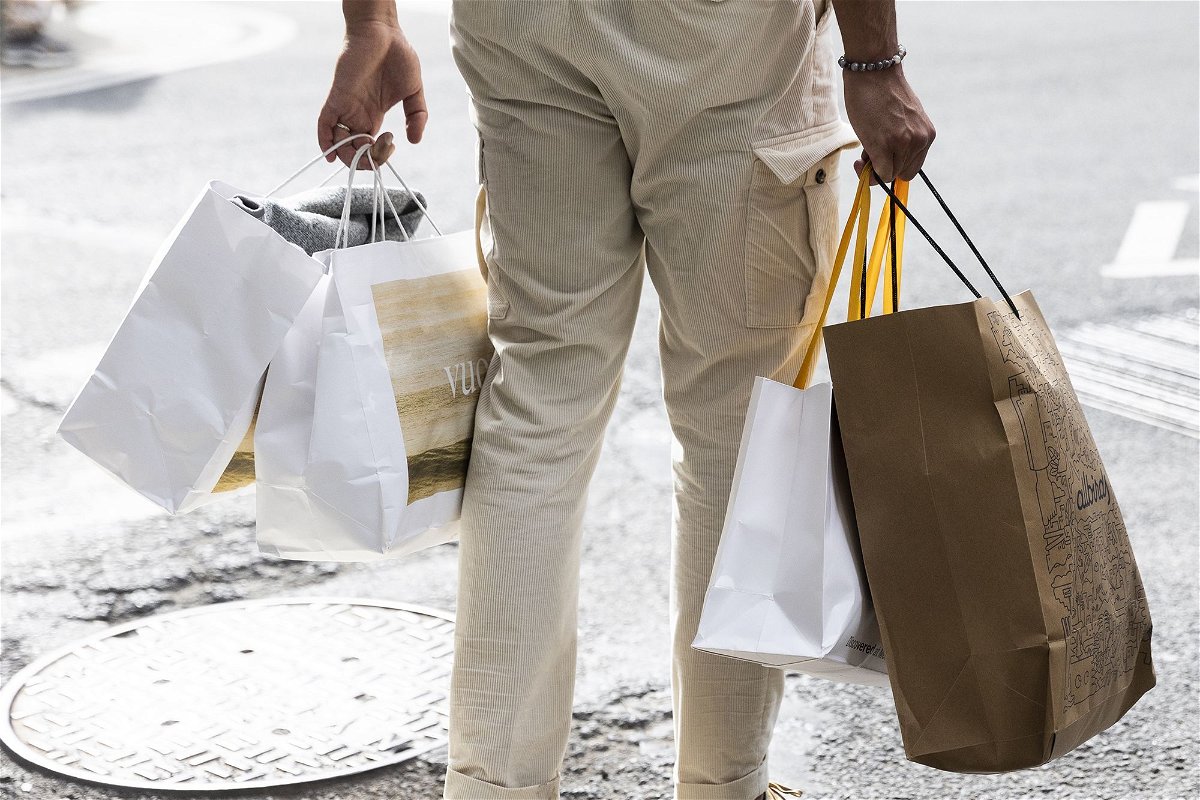Retail spending rebounded in April

Spending at US retailers rose in April. A pedestrian carries shopping bags in the SoHo neighborhood of New York
By Bryan Mena, CNN
Washington, DC (CNN) — Spending at US retailers rose in April following two months of declines, showing the US consumer is still fueling the economy.
Retail sales, which are adjusted for seasonality but not for inflation, rose by 0.4% in April from the prior month, the Department of Commerce reported on Tuesday. That’s a weaker gain than the 0.8% increase that economists were expecting, according to Refinitiv.
The April increase was driven by spending at car dealerships, restaurants, online, and at “miscellaneous” stores such as floral shops and pet supply stores. Americans curbed their spending on sporting goods, furniture, electronics and at gas stations that month.
Retail sales fell by a downwardly revised 0.7% in March, in part due to lower gas prices and lower spending on durable goods.
From the same month a year ago, retail spending grew 1.6% in April, which was the weakest year-over-year increase since the early months of the pandemic.
“April’s retail sales numbers speak to the resiliency of the economy,” said Natalie Kotlyar, national practice leader of BDO’s retail and consumer products industry. “Consumers are also prioritizing travel and experiences, like dining out.”
Robust labor market is still fueling spending
The US job market remains robust, which has fueled spending. Employers added 253,000 jobs in April, a strong gain by historical standards, and average hourly earnings grew in April by 16 cents, or 0.5%, to $33.36. The unemployment rate fell back to a 53-year low that month.
“At the end of the day, the labor market is what determines consumer spending because the number of jobs created plus wage gains determine personal income growth and that in turn drives consumer spending,” said Kathy Bostjancic, chief economist at Nationwide Mutual.
Bostjancic, like many other economists, expects the US economy to slip into a recession later in the year as the labor market weakens and consumers curb their spending. She said she expects the unemployment rate to rise steadily to as high as 5.5% in the middle of 2024.
An economic slowdown will be driven in part by tighter credit conditions, which only intensified after the failures of Silicon Valley Bank and Signature Bank in March, according to a recent survey of senior loan officers gauging lending activity in the first quarter. It’ll only get harder to borrow in the months ahead, economists said.
Tougher lending standards means consumers can’t spend as much and that businesses will have a harder time expanding operations or taking on new projects, a typical development before an economic downturn, according to Michael Reynolds, vice president of investment strategy at Glenmede.
“That’s the recession playbook and we think we’re in the early stages of that,” Reynolds said. “If a business lays off a worker, then that worker cuts back on their spending, which is revenue for another company that will eventually have to lay off some workers too, then you can see that just compound and compound.”
A key measure of business investment, new orders for nondefense capital goods excluding aircraft, declined in four of the past five months through March. In the first quarter, businesses also cut their spending on equipment, according to the Commerce Department’s latest GDP report.
“Nonprofit organizations reported that heightened uncertainty in the banking sector limited their access to credit and delayed ongoing affordable housing and community support projects,” the Fed’s latest Beige Book report said.
The erosion of demand is a goal of the Federal Reserve, which is trying to slow the economy to tamp down high inflation. Fed officials voted earlier this month to raise the central bank’s benchmark lending rate by a quarter point to 5-5.25%.
The Consumer Price Index rose 4.9% for the 12 months ended in April, according to the Bureau of Labor Statistics, a slightly slower pace than the 5% year-on-year rise in March. Fed officials expect inflation to cool further for the rest of the year as American consumers slash their spending, likely on goods first, according to economists.
Consumer spending on goods was strong in the first quarter, but the Institute for Supply Management’s April survey showed that new demand for manufactured goods remained in contraction territory for the eighth month in a row. Spending on services and in-person experiences has been robust in recent months and is expected to continue through the summer.
The-CNN-Wire
™ & © 2023 Cable News Network, Inc., a Warner Bros. Discovery Company. All rights reserved.